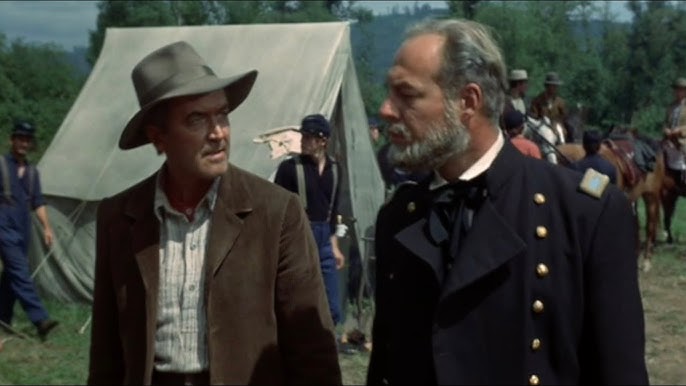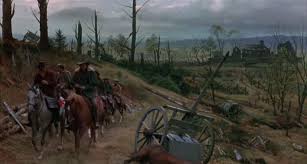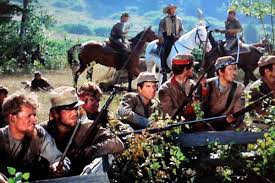🎬 Shenandoah (1965)

Shenandoah (1965) Review: A Powerful Civil War Drama of Family and Morality
Shenandoah, directed by Andrew V. McLaglen, is a poignant Civil War drama that transcends the battlefield to focus on the struggles of a single family caught in the crossfire of a divided nation. Starring James Stewart in one of his most compelling roles, the film delves into themes of family, morality, and the costs of war. With its heartfelt performances and emotionally charged narrative, Shenandoah is a timeless exploration of how war affects those who never sought to fight it.
Plot Overview: A Family’s Unwilling Journey into War
The story is set in 1864 in the Shenandoah Valley of Virginia. Charlie Anderson (James Stewart) is a widowed farmer determined to keep his family neutral in the Civil War, despite living in Confederate territory. With six sons, a daughter, and a daughter-in-law, Charlie insists on maintaining their independence and staying out of the conflict.
However, their peaceful existence is shattered when Charlie’s youngest son, Boy (Phillip Alford), is mistakenly captured by Union soldiers and accused of being a Confederate soldier. Charlie and his family embark on a dangerous mission to rescue him, navigating a war-torn landscape and facing the moral dilemmas and tragedies of the Civil War along the way.
James Stewart as Charlie Anderson: A Towering Performance
James Stewart delivers a masterful performance as Charlie Anderson, portraying him as a principled, stubborn, and deeply moral man. Stewart’s portrayal captures Charlie’s inner conflict as he grapples with his desire to protect his family and his growing realization that neutrality is impossible in the face of war. His heartfelt delivery of the film’s emotional monologues and his commanding presence anchor the story, making Charlie one of Stewart’s most memorable roles.
Supporting Cast: A Strong Ensemble
- Doug McClure as Sam: McClure plays Sam, the Confederate soldier who marries Charlie’s daughter, Jennie (Rosemary Forsyth). His character highlights the challenges of balancing personal loyalties with family commitments.
- Phillip Alford as Boy: Alford’s portrayal of the youngest Anderson child provides the emotional catalyst for the family’s journey, capturing the innocence and vulnerability of youth in a time of war.
- Katharine Ross as Ann Anderson: In her film debut, Ross brings warmth and depth to the role of Ann, the Anderson family’s compassionate and resilient daughter-in-law.
- Glenn Corbett as Jacob Anderson: Corbett’s portrayal of the eldest Anderson son emphasizes the family’s internal struggles and the weight of responsibility borne by the siblings.
Themes: Family, Neutrality, and the Cost of War
- The Illusion of Neutrality: The film explores the futility of attempting to remain neutral in a conflict as pervasive and devastating as the Civil War. Charlie’s initial stance is tested as the war encroaches on his family’s life.
- The Strength of Family Bonds: At its core, Shenandoah is about the unbreakable ties of family, emphasizing their importance in the face of hardship and loss.
- The Human Cost of War: The film portrays the toll of war on both soldiers and civilians, highlighting its capacity to destroy lives and disrupt entire communities.

Direction and Cinematography: A Poignant and Expansive Vision
Andrew V. McLaglen’s direction balances intimate family drama with sweeping shots of the Shenandoah Valley, capturing both the beauty of the landscape and the devastation wrought by war. The cinematography by William H. Clothier emphasizes the contrast between the natural tranquility of the valley and the chaos of the Civil War, heightening the film’s emotional impact.
Music: A Stirring Score by Frank Skinner
Frank Skinner’s musical score complements the film’s emotional depth, blending traditional American folk melodies with original compositions. The recurring theme of “Oh Shenandoah” serves as a haunting reminder of the valley’s beauty and the Anderson family’s connection to their land.
Key Moments That Define Shenandoah
- Charlie’s Grace at the Dinner Table: In this iconic scene, Charlie prays over a meal, thanking God for nothing, as he credits only his family’s hard work for their success. This moment encapsulates his independence and skepticism of outside forces.
- The Family’s Quest for Boy: The Anderson family’s journey to rescue Boy is filled with tension, heartache, and moral dilemmas, highlighting the personal costs of war.
- The Emotional Reunion: The film’s climactic and bittersweet resolution delivers a powerful emotional payoff, leaving a lasting impression on viewers.
Strengths of Shenandoah
- James Stewart’s Performance: Stewart’s portrayal of Charlie Anderson is the heart of the film, blending humor, wisdom, and emotional depth.
- Emotional Resonance: The film’s exploration of family and morality strikes a universal chord, making its themes timeless and relatable.
- Authentic Atmosphere: The attention to historical detail, combined with the film’s naturalistic cinematography, immerses viewers in the Civil War era.
- Powerful Music: Frank Skinner’s score and the use of “Oh Shenandoah” enhance the film’s emotional and thematic impact.
Weaknesses of Shenandoah
- Simplified Conflict: The film avoids delving deeply into the political complexities of the Civil War, focusing instead on the personal and familial aspects of the conflict.
- Pacing Issues: Some sections of the film feel slow, particularly in the first act, as the story builds toward its central conflict.
- Predictable Plot: While emotionally impactful, the narrative follows a somewhat conventional structure, with few surprises.

Legacy and Reception
Shenandoah was a commercial and critical success upon its release, praised for its heartfelt performances, emotional storytelling, and themes of family and morality. It has since become a beloved classic, particularly for fans of historical dramas and James Stewart’s extensive filmography. The film’s exploration of the human side of war continues to resonate, making it a staple of Civil War cinema.
Fun Facts About Shenandoah
- Stage Adaptation: The film was later adapted into a successful Broadway musical in 1975, featuring a score by Gary Geld and Peter Udell.
- Stewart’s Personal Touch: James Stewart reportedly identified with Charlie Anderson’s independence and skepticism, adding authenticity to his performance.
- Historical Inspiration: While fictional, the film draws on the real experiences of families living in Virginia’s Shenandoah Valley during the Civil War.
Conclusion: A Timeless Tale of Family and Resilience
Shenandoah (1965) is a deeply moving and thought-provoking film that uses the backdrop of the Civil War to explore universal themes of family, morality, and the cost of conflict. Anchored by James Stewart’s powerful performance and enriched by stunning visuals and a memorable score, the film remains a classic of American cinema. Its message of compassion and resilience continues to resonate, making it a must-watch for fans of historical dramas and character-driven storytelling.